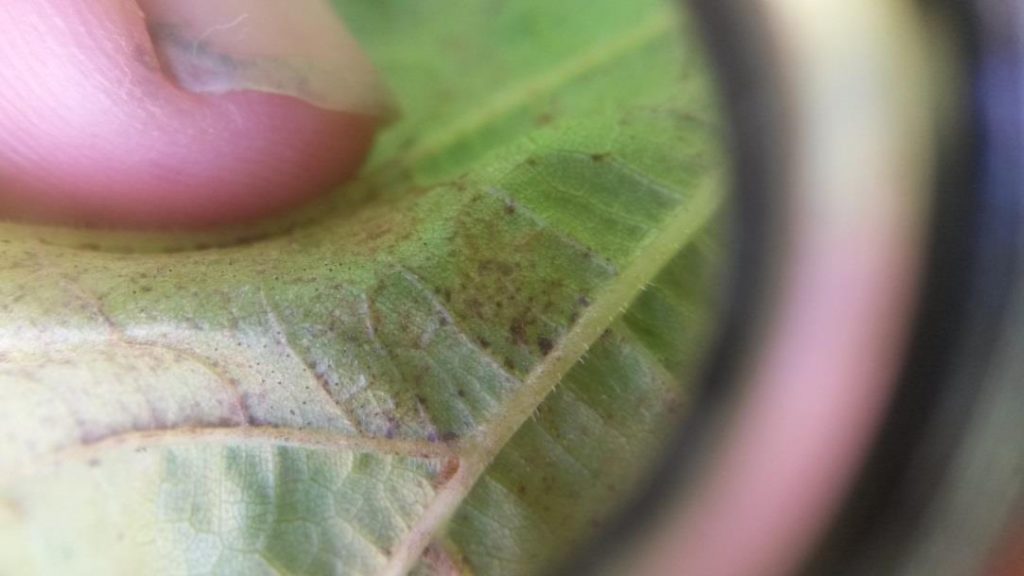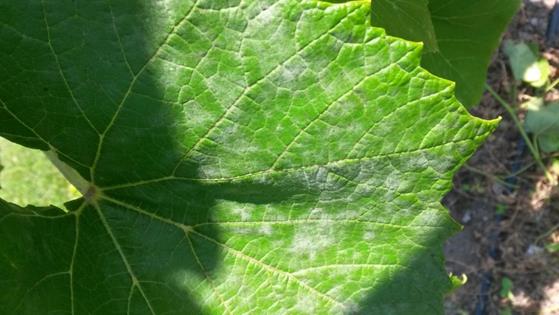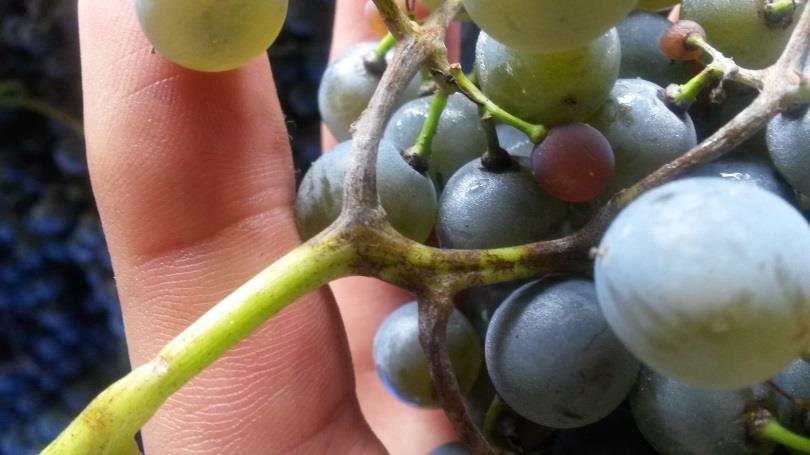Grape Disease Update and Grape Disease Scouting
Grape scouting at the Peninsular Agricultural Research Station began on May 18th shortly after bud burst. The West Madison Agricultural Research Station was scouted for the 4th time on May 22nd, where shoots are currently about a foot long. The warm, dry weather throughout much of southern Wisconsin and Door County caused a strong flush of growth at over the past week, but has not been favorable for disease due to the absence of free water for spore germination. No powdery mildew, downy mildew, Phomopsis, or black rot symptoms have been detected yet at either site. However, with lots of rain in the forecast for most of Wisconsin in the next several days and daily highs projected to consistently warm past 60 degrees, this will likely change. Your weekly scouting program should be in place at this time. Keep a particular eye on the developing grape blossoms this week, as a preventative spray against black rot and downy mildew will need to be made just before grape blossoms open.
This is a great time to refresh on some of the basics of grape scouting, as disease symptoms may begin to appear in the next few weeks. This week we will be talking about several important steps to effectively scouting your vineyard. Here are some of the strategies that we use to make sure that we stay on top of diseases as they develop and make accurate diagnoses:
1.) Invest in a hand-lens or headband magnifier (e.g. Optivisor). Hand lenses and headband magnifiers are critical tools for good scouting, particularly when we are looking for fungi and fungus-like organisms. This is because they allow us to see spores or fungal fruiting bodies that are often difficult to see with the naked eye, lessening the risk of making an incorrect diagnosis and taking the wrong action in your vineyard. For example, black rot leaf lesions are cream to tan colored with a reddish to reddish brown exterior. In addition, they are always sprinkled with small black pimples, called pycnidia. Herbicide damage, mechanical damage, micronutrient deficiency, and a wide variety of other agents can all cause cream or brown colored lesions. These spots are sometimes colonized by opportunistic fungi, so there may be a few fruiting bodies, but they lack the numerous black pycnidia we see with black rot. A check with a hand lens will easily tell the difference, and could save a spray. The same principle applies to powdery mildew and downy mildew, which each make distinctive spore structures that that are invisible to the naked eye.

2.) Check both sides of multiple leaves on each plant, selecting both old and new leaves and holding each side in direct sunlight as you scout. This is particularly critical in identifying powdery mildew and downy mildew. Powdery mildew tends to colonize the adaxial (upper) side of a leaf, while downy mildew tends to sporulate from the abaxial (bottom) side of the leaf. Furthermore, early season powdery mildew colonies are often only visible in direct sunlight. Focus your early-season scouting efforts on plant parts near where pathogens overwinter. For example, downy mildew symptoms are often first seen on lower leaves or suckers because the downy mildew pathogen overwinters on the ground, whereas black rot symptoms are usually first seen in close proximity to mummified fruit either left on spurs or on the ground.

3.) Don’t forget to scout your fruit. Diseases such as black rot on clusters tend to easily catch your eye as you scout, but don’t forget that diseases like powdery mildew are harder to see, and can infect both fruit and rachis tissue. Powdery mildew infection on developing rachis and fruit tissue can result in uneven sizing and problems with ripening. In extreme cases, fruit can even crack open due to poor expansion of the fruit epidermis. Always inspect several clusters on each plant you scout, paying attention to both berries and rachis tissue.
4.) Don’t forget about insect damage, micronutrient deficiency, and mechanical damage as you scout for fungi. Remember, not all spots, patterns, or lesions are caused by fungi or fungus-like organisms. Keep an open mind when scouting, use your hand lens, and remember what the specific symptoms of economic diseases are. When in doubt, contact a UW diagnostics specialist, information provided below.

5.) Practice regular scouting. Scout at least once per week, covering plants throughout the entire vineyard. Diseases like downy mildew and powdery mildew can go from several isolated infections to an outbreak in a matter of only a few days in a conducive environment, so it is critical that vineyards are checked routinely. Be sure to carry flagging tape to mark vines with questionable symptoms so that you can readily find them later to follow up on development or to collect samples for lab analysis. Remember, the effectiveness of a scouting program is limited if it is not implemented with the appropriate frequency.
Additional Resources: A good scouting program will help keep you informed as you identify problems each year, but it is also no guarantee that you will be able to identify everything you find. If in doubt, don’t forget about the UW-Diagnostic Clinic, the UW-Insect Diagnostics Lab, and the UW-Soil and Forage Lab. If at any point during the season you experience a problem that you are not familiar with, send a sample to the appropriate lab here at the UW for identification. Correct diagnosis means the correct response, saving you time and money in the future.
UW-Madison Plant Disease Diagnostic Clinic: http://labs.russell.wisc.edu/pddc/
UW-Madison Insect Diagnostic Lab: http://labs.russell.wisc.edu/insectlab/
UW-Madison Soil and Forage Lab: https://uwlab.soils.wisc.edu/fees/
This article was posted in Grapes, WFN, Vol. 1-4 and tagged David S. Jones, disease, Grapes, Patty McManus.
